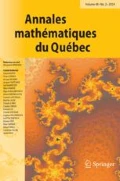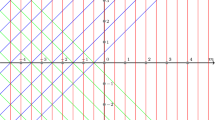Abstract
In 1956, Pleijel gave his celebrated theorem showing that the inequality in Courant’s theorem on the number of nodal domains is strict for large eigenvalues of the Laplacian. This was a consequence of a stronger result giving an asymptotic upper bound for the number of nodal domains of the eigenfunction as the eigenvalue tends to \(+\infty \). A similar question occurs naturally for the case of the Schrödinger operator. The first significant result has been obtained recently by the first author for the case of the harmonic oscilllator. The purpose of this paper is to consider more general potentials which are radial. We will analyze either the case when the potential tends to \(+\infty \) or the case when the potential tends to zero, the considered eigenfunctions being associated with the eigenvalues below the essential spectrum.
Résumé
En 1956, \(\AA \). Pleijel a démontré qu’il peut seulement y avoir un nombre fini d’égalités dans le théorème de Courant sur les fonctions propres du laplacien. Ce résultat était accompagné d’une borne supérieure sur le nombre de domaines nodaux des fonctions propres lorsque les valeurs propres tendent vers l’infini. Il est naturel de supposer qu’un résultat similaire peut être démontré dans le cas de l’opérateur de Schrödinger. Le premier résultat significatif dans cette direction a été obtenu par le premier auteur pour l’oscillateur harmonique. L’objectif de cet article est de traiter le cas de potentiels radiaux plus généraux. Nous traiterons les cas où le potentiel tend vers \(+\infty \) ou les cas où le potentiel tend vers zéro, les fonctions propres correspondant à la partie discrète du spectre.
Similar content being viewed by others
References
Beals, R.: A general calculus of pseudo-differential operators. Duke Math. J. 42, 1–42 (1975)
Bérard, P., Helffer, B.: On the nodal patterns of the 2D isotropic quantum harmonic oscillator. arXiv:1506.02374 (2015)
Bérard, P., Meyer, D.: Inégalités isopérimétriques et applications. Annales scientifiques de l’École Normale Supérieure, Sér. 4 15(3), 513–541 (1982)
Bourgain, J.: On Pleijel’s nodal domain theorem. Int. Math. Res. Not. 6, 1601–1612 (2015). arXiv:1308.4422
Charron, P.: Théorème de Pleijel pour l’oscillateur harmonique quantique. Mémoire de Maîtrise. Université de Montréal (2015)
Charron, P.: A Pleijel-type theorem for the quantum harmonic oscillator. J. Spectr. Theory arXiv:1512.07880 (2016) (to appear)
Courant, R.: Ein allgemeiner Satz zur Theorie der Eigenfunktionen selbstadjungierter Differentialausdrücke. Nachr. Ges. Göttingen 81–84 (1923)
Cowan, C.: Optimal Hardy inequalities for general elliptic operators with improvements. Commun. Pure Appl. Math. 9, 109–140 (2010)
Cwikel, M.: Weak type estimates for singular values and the number of bound states. Ann. Math. 106, 93–100 (1977)
De Carli, L., Hudson, S.M.: A Faber–Krahn inequality for solutions of Schrödinger’s equation. Adv. Math. 230, 2416–2427 (2012)
Faber, C.: Beweis, dass unter allen homogenen Membrane von gleicher Fläche und gleicher Spannung die kreisförmige die tiefsten Grundton gibt. Sitzungsber. Bayer. Akad. Wiss. Math. Phys. München 169–172 (1923)
Helffer, B., Hoffmann-Ostenhof, T.: A review on large k minimal spectral \(k\)-partitions and Pleijel’s theorem. In: Spectral Theory and Partial Differential Equations, Contemporary of Mathematics, vol. 640, pp .39–57. arXiv:1509.04501 (2015)
Helffer, B., Persson-Sundqvist, M.: On nodal domains in Euclidean balls. Proc. Amer. Math. Soc. 144(11), 4777–4791 (2016)
Hoffmann-Ostenhof, M., Hoffmann-Ostenhof, T.: Local properties of solutions of Schrödinger equations. Commun. Partial Differ. Equ. 17(3–4), 491–522 (1992)
Hörmander, L.: The Weyl calculus of pseudodifferential operators. Commun. Pure Appl. Math. 32, 359–443 (1979)
Hörmander, L.: On the asymptotic distribution of the eigenvalues of pseudodifferential operators in \(\mathbb{R}^n\). Arkiv för matematik 17(3), 297–313 (1979)
Krahn, E.: Über eine von Rayleigh formulierte minimal Eigenschaft des Kreises. Math. Ann. 94, 97–100 (1925)
Leydold, J.: Knotenlinien und Knotengebiete von Eigenfunktionen. Diplom Arbeit, Universität Wien (1989)
Lieb, E.H.: Bounds on the eigenvalues of the Laplace and Schrdinger operators. Bull. Am. Math. Soc. 82, 751–753 (1976)
Milnor, J.: On the Betti numbers of real varieties. Proc. Am. Math. Soc. 15, 275–280 (1964)
Mohamed, A.: Comportement asymptotique, avec estimation du reste, des valeurs propres d’une classe d’opérateurs pseudo-différentiels sur \(\mathbb{R}^n\). Math. Nachr. 140, 127–186 (1989)
Peetre, J.: A generalization of Courant nodal theorem. Math. Scand. 5, 15–20 (1957)
Pleijel, Å.: Remarks on Courant’s nodal theorem. Commun. Pure. Appl. Math. 9, 543–550 (1956)
Polterovich, I.: Pleijel’s nodal domain theorem for free membranes. Proc. Am. Math. Soc. 137(3), 1021–1024 (2009)
Reed, M., Simon, B.: Method of Modern Mathematical Physics IV: Analysis of operators. Academic Press, New York (1978)
Robert, D.: Propriétés spectrales d’opérateurs pseudo-différentiels. Commun. PDE 3(9), 755–826 (1978)
Rosenbljum, G.V.: The distribution of the discrete spectrum for singular differential operators. Sov. Math. Dokl. 13, 245–249 (1972)
Shubin, M.A.: Asymptotic behaviour of the spectral function. In: Pseudodifferential Operators and Spectral Theory, pp. 133–173. Springer, Berlin, Heidelberg (2001)
Shubin, M.A., Tulovskii, V.N.: On the asymptotic distribution of the eigenvalues of pseudodifferential operators in \(\mathbb{R}^n\). Mat. Sb. 92(134), 571–588 (1973). (in Russian)
Steinerberger, S.: A geometric uncertainty principle with an application to Pleijel’s estimate. Ann. Henri Poincaré 15(12), 2299–2319 (2014)
Tamura, H.: Asymptotic formulas with remainder estimates for eigenvalues of Schrödinger operators. Commun. Partial Differ. Equ. 7(1), 1–53 (1982)
Tamura, H.: Asymptotic formulas with sharp remainder estimates for bound states of Schrödinger I. J. Anal. Math. 40, 166–182 (1981)
Tamura, H.: Asymptotic formulas with sharp remainder estimates for bound states of Schrödinger II. J. Anal. Math. 41, 85–108 (1982)
Weyl, H.: Über die asymptotische Verteilung der Eigenwerte. Nachrichten der Königlichen Gesellschaft der Wissenschaften zu Göttingen 110–117 (1911)
Acknowledgements
Thanks to the ESI where the paper was initiated (B. H. and T. H.-O.). The authors would also thank I. Polterovich for helpful discussions at various stages of this work.
Author information
Authors and Affiliations
Corresponding author
Rights and permissions
About this article
Cite this article
Charron, P., Helffer, B. & Hoffmann-Ostenhof, T. Pleijel’s theorem for Schrödinger operators with radial potentials. Ann. Math. Québec 42, 7–29 (2018). https://doi.org/10.1007/s40316-017-0078-x
Received:
Accepted:
Published:
Issue Date:
DOI: https://doi.org/10.1007/s40316-017-0078-x



